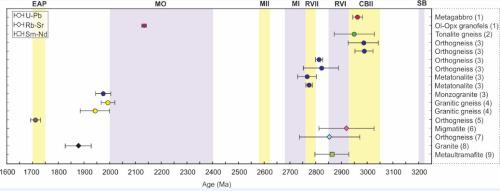Geoscience Frontiers ( IF 8.5 ) Pub Date : 2021-04-06 , DOI: 10.1016/j.gsf.2021.101201 Marco Aurélio Piacentini Pinheiro , George L. Guice , Joana Reis Magalhães

|
The Campos Gerais Domain (CGD) in south-eastern Brazil is an approximately 180 km x 35 km area of Archean–Proterozoic rocks located southwest of the São Francisco Craton (SFC). The Archean–Paleoproterozoic evolution of the CGD — alongside its potential correlation with the SFC or other cratonic blocks in the region — is currently poorly-constrained. We present the results of systematic petrography, bulk-rock geochemistry, mineral chemistry and geochronology for a suite of scarcely studied mafic–ultramafic rocks from the CGD. We also provide a compilation of previously reported bulk-rock geochemical and spinel group mineral chemical data for mafic–ultramafic rocks throughout the CGD, and geochronological information for various lithotypes in the region. The CGD records a protracted Mesoarchean to Statherian (3.1 to 1.7 Ga) crustal evolution, which we interpret to share a common history with the southern SFC and their related reworked segments, suggesting that it is a westward extension of this cratonic terrain. The metavolcano-sedimentary rocks of the Fortaleza de Minas and Alpinópolis segments represent a Mesoarchean greenstone belt that is stratigraphically and chemically comparable to Archean greenstone belts worldwide, and that is broadly coeval with a local suite of tonalite-trondhjemite-granodiorite (TTG) gneisses and migmatites. U-Pb SHRIMP zircon data from a subalkaline metagabbro yielded a concordia age of ca. 2.96 Ga, revealing a previously unrecognized phase of Archean magmatism in the CGD that can be chrono-correlated with metakomatiite and TTG generation elsewhere in the São Francisco paleocontinent. Our data contradict a hypothesis whereby the metavolcano-sedimentary rocks of the Jacuí-Bom Jesus da Penha and Petúnia segments represent an ophiolite, as previously suggested, instead presenting features that point to formation in association with a continental arc. Coupled with a U-Pb (SHRIMP) crystallization age of ca 2.13 Ga recorded by zircon grains from a metaultramafic rock, these data highlight that a magmatic event was chrono-correlated with the main accretionary phase of the Minas Orogeny, and with the Pouso Alegre/Amparo and São Vicente complexes. Finally, a U-Pb (SHRIMP) concordia age of ca. 590 Ma — obtained from metamorphic-textured zircon grains from a metaultramafic rock — points to a late metamorphic overprint related to upper amphibolite conditions, brittle fault activation and the juxtaposition of crustal blocks in association with the latest stages of western Gondwana’s assembly in the southern SFC, with later retrogression to greenschist-facies.
中文翻译:

Campos Gerais区域的太古宙—爱迪亚卡兰演化—圣弗朗西斯科古大陆的重造边缘(巴西东南部):变质—超岩性岩石的约束
巴西东南部的Campos Gerais域(CGD)是位于圣弗朗西斯科·克拉顿(SFC)西南约180 km x 35 km的太古代—元古代岩石区。CGD的太古宙古生代演化及其与该地区的SFC或其他克拉通块体的潜在联系,目前受到的制约很有限。我们介绍了来自CGD的一组研究较少的镁铁质-超镁铁质岩体的系统岩石学,块岩地球化学,矿物化学和地质年代学的结果。我们还提供了以前报道的整个CGD中镁铁质-超镁铁质岩石的块状岩石地球化学和尖晶石族矿物化学数据的汇编,以及该地区各种岩石类型的地质年代信息。CGD记录了从Mesoarchean到Statherian(3.1至1.7 Ga)的长时间地壳演化,我们将其解释为与南部证监会及其相关的返工部分拥有共同的历史,这表明这是该克拉通地带的向西延伸。福塔雷萨德米纳斯和阿尔皮诺波利斯段的准火山沉积岩代表了一种中地古代的绿岩带,在地层和化学上可与世界范围的古宙斯绿岩带相媲美,并且与当地的一套斜长石-长白云母-闪长闪长岩(TTG)片麻岩和migmatites。来自亚碱金属代谢物的U-Pb SHRIMP锆石数据得出的共生年龄约为。2.96 Ga,揭示了CGD中以前未被认识的太古宙岩浆作用阶段,该阶段可能与圣弗朗西斯科古大陆其他地方的变辉石和TTG产生年代相关。我们的数据与一个假设相反,该假设认为Jacuí-BomJesus da Penha和Petúnia段的超火山沉积岩代表蛇绿岩,如先前所建议的,而是呈现出与大陆弧相关的指向地层的特征。这些数据再加上由米托拉马菲克岩中的锆石晶粒记录的大约2.13 Ga的U-Pb(SHRIMP)结晶年龄,这些数据突出表明,岩浆事件与米纳斯造山运动的主要增生阶段以及与波苏阿莱格里呈时间相关。 / Amparo和SãoVicente复合体。最后,U-Pb(SHRIMP)的共生年龄约为。590 Ma(从陨铁质岩石中的变质织构的锆石晶粒中获得)指出了与上部闪石条件有关的晚期变质叠印,











































 京公网安备 11010802027423号
京公网安备 11010802027423号